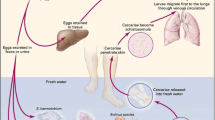Abstract
Schistosomiasis is one of the major parasitic diseases with more than 200 million people infected worldwide every year. Praziquantel is the drug of choice against the schistosomiasis although the use of a single drug to treat such a large amount of infected people appears particularly worrisome. For this reason, the search of new schistosomicidal compounds is viewed as an urgent goal and a number of screening campaigns have been carried out in the past years. The larval stage of Schistosoma (schistosomula) has been widely used in order to identify new compounds against the parasite. Here we describe detailed practical procedures for a luminescence-based assay proven to be highly effective for the selection of schistosomicidal compounds on small and medium-high scale. The assay is based on the quantitation of the parasite ATP, a good indicator of metabolically active cells, as measure of schistosomula viability. This assay is fast and reproducible, and it is suitable either for manual or for semiautomated screenings.
Access this chapter
Tax calculation will be finalised at checkout
Purchases are for personal use only
Similar content being viewed by others
References
McManus DP, Dunne DW, Sacko M et al (2018) Schistosomiasis. Nat Rev Dis Primers 4(1):13. https://doi.org/10.1038/s41572-018-0013-8
Peak E, Chalmers IW, Hoffmann KF (2010) Development and validation of a quantitative, high-throughput, fluorescent-based bioassay to detect schistosoma viability. PLoS Negl Trop Dis 4(7):e759. https://doi.org/10.1371/journal.pntd.0000759
Mansour NR, Bickle QD (2010) Comparison of microscopy and Alamar blue reduction in a larval based assay for schistosome drug screening. PLoS Negl Trop Dis 4(8):e795. https://doi.org/10.1371/journal.pntd.0000795
Paveley RA, Mansour NR, Hallyburton I et al (2012) Whole organism high-content screening by label-free, image-based Bayesian classification for parasitic diseases. PLoS Negl Trop Dis 6(7):e1762. https://doi.org/10.1371/journal.pntd.0001762
Lalli C, Guidi A, Gennari N et al (2015) Development and validation of a luminescence-based, medium-throughput assay for drug screening in Schistosoma mansoni. PLoS Negl Trop Dis 9(1):e0003484. https://doi.org/10.1371/journal.pntd.0003484
Guidi A, Lalli C, Gimmelli R et al (2017) Discovery by organism based high-throughput screening of new multi-stage compounds affecting Schistosoma mansoni viability, egg formation and production. PLoS Negl Trop Dis 11(10):e0005994. https://doi.org/10.1371/journal.pntd.0005994
Tucker MS, Karunaratne LB, Lewis FA et al (2013) Schistosomiasis. Curr Protoc Immunol 103:Unit 19.1. https://doi.org/10.1002/0471142735.im1901s103
Brink LH, McLaren DJ, Smithers SR (1977) Schistosoma mansoni: a comparative study of artificially transformed schistosomula and schistosomula recovered after cercarial penetration of isolated skin. Parasitology 74(1):73–86
Protasio AV, Dunne DW, Berriman M (2013) Comparative study of transcriptome profiles of mechanical– and skin–transformed Schistosoma mansoni schistosomula. PLoS Negl Trop Dis 7(3):e2091. https://doi.org/10.1371/journal.pntd.0002091
Acknowledgments
A.B. and G.R. are supported by CNR (National Research Council)-CNCCS (Collezione Nazionale di Composti Chimici e Centro di screening) “Rare, Neglected and Poverty Related Diseases—Schistodiscovery Project” (DSB.AD011.001.003).
Author information
Authors and Affiliations
Corresponding author
Editor information
Editors and Affiliations
Rights and permissions
Copyright information
© 2020 Springer Science+Business Media, LLC, part of Springer Nature
About this protocol
Cite this protocol
Guidi, A., Gimmelli, R., Bresciani, A., Ruberti, G. (2020). Luminescence-Based, Low- and Medium-Throughput Assays for Drug Screening in Schistosoma mansoni Larval Stage. In: Timson, D.J. (eds) Schistosoma mansoni. Methods in Molecular Biology, vol 2151. Humana, New York, NY. https://doi.org/10.1007/978-1-0716-0635-3_18
Download citation
DOI: https://doi.org/10.1007/978-1-0716-0635-3_18
Published:
Publisher Name: Humana, New York, NY
Print ISBN: 978-1-0716-0634-6
Online ISBN: 978-1-0716-0635-3
eBook Packages: Springer Protocols




